
9 minute read
Motoring
The Hyundai Kona: It’s ‘N’ for a new direction in looks and performance KONA N: SUV COVERS NEW GROUND
By DEREK OGDEN
It appears the ‘go-faster’ guys and gals at Hyundai cannot keep their hands off the company’s product. Following the performance upgrade to the i30 and i20, most recent model to get a booster jab in the arm is the most unlikely – the Kona sports utility vehicle.
A product of the Hyundai N Division at Namyang, South Korea, and put through exhaustive testing at the Nurburgring in Germany, the Konan N is the harbinger of a new class of hot SUVs.
With 73 corners covering 20.8 kilometres of tarmac, with stretches of steep uphill and downhill going, the circuit’s Nordschleife section earns its reputation as the Green Hell, pushing the high performers of the automotive world to the ultimate in on-road conditions. So, does the Kona N ft?
Lifted from the underpinnings of the Hyundai i30 hatchback, with more than a pinch of N-ness, it’s hard to ft it into the pantheon. For a start, there’s no all-wheel drive, so it is a high-riding hot hatch rather than an SUV.
Front-wheel drive only has helped keep the weight down, enabling a claim by the maker of a zero-to-100km/h fgure of 5.5 seconds, just a tenth slower than the i30 N hatch.
Two models have come Down Under – Kona N and Kona N Premium – priced from $48,000 and $51,000, plus onroad costs, respectively. Metallic paint adds $595 and matte paint $1000.
Both are powered by a 2.0-litre turbo-petrol four-cylinder engine, mated with an eight-speed dual-clutch transmission, serving up 206 kW and 392 Nm through the front wheels.
STYLING
The standard Atlas White Kona N test car turned heads more than once. The front followed the Hyundai N tradition with the black grille, following the rally team, being based on a chequered fag. The Hyundai ‘H’ and performance ‘N’ were in there for good measure.
Below is another grille, less of a stand-out, while an LED headlamp set-up features on either side capped by strips of LED daytime running lights.
The rear roofine incorporates a discreet spoiler, while the dominating features are twin trumpet-tipped exhausts totally in keeping with the brassy note emanating from them when the engine is fred up.
In profle, the features probably responsible for the onlooker interest mentioned above, are unique 19-inch alloy wheels shod with Pirelli P Zero HN tyres, playing host to bright red brake callipers.
All these captivating aspects of the standard Atlas White Kona N test car exterior were linked by a fne red line skirting the lower body.
INTERIOR
The Kona N inside is far from basic. Sports seats, with a nice line in fabric and contrasting stitching, are bucket-style up front, while the second row can take three grown-ups at a pinch. Leg room there is average to skinny depending on the position of the front occupants.
Fancy suede / leather coverings are left to the Premium model. The steering wheel is the exception, with leather wrapping giving the driver a touch of luxury.
The Kona N Premium also weighs in with autodimming rear-view mirror, head-up display, front parking sensors, powered, heated and ventilated front seats, heated steering wheel, glass sunroof and ambient lighting.


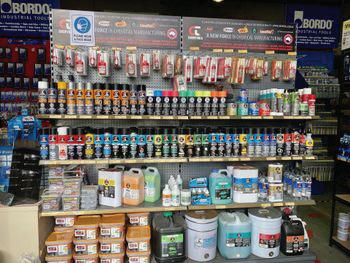

INFOTAINMENT
The driver has the beneft of a new 10.25-inch digital instrument cluster, while another 10.25-inch display screen in the central dashboard supplies information on vehicle systems and wired Apple CarPlay and Android Auto, plus factory ftted satellite navigation.
Quality audio is served
up with DAB+ digital radio being blessed with an eight-speaker harman / kardon sound system. Wireless phone charging caps off the line-up.
ENGINES / TRANSMISSIONS
Power is provided by a 2.0-litre turbo-petrol fourcylinder engine putting power to ground, via an eight-speed double clutch automatic transmission, to ground through the front wheels.
SAFETY
Standard equipment includes autonomous emergency braking with detection of the presence of pedestrian or cyclist, adaptive cruise control, blind spot warning, lane keep and lane follow assist, rear cross-traffc alert and auto high beam.
DRIVING
Driving the Kona N was full of ups and downs - literally. The stiff suspension picking up every blemish in the road, even in Normal drive mode. The racetrack would be more welcoming.
Peak power is on tap between 5500 and 6000 rpm, with torque chiming in from 2100 to 4700 revs. Gear changes are some of the smoothest, with just a slight nudge between cogs.
Hyundai puts the combined urban / highway fuel (premium unleaded) consumption at 9 litres per 100 kilometres. The test car came up with more than 11 litres per 100 kilometres in town and 5.9 on the motorway.
Everything worked a treat while going forward but in reverse, the vehicle tended to stutter when setting off on an incline. Not the best when backing out of the driveway. Exhaust performance ranges from producing from a peaceful background noise when cruising to a gravelly
chorus when called on to get a move on.
‘Grin Shift’ is hard to take seriously. Brought into action by the press of a red button on the steering wheel, the throttle response and gear shifts are speeded up for 20 seconds – there’s a countdown - with an accompanying crackle and pop of the engine. So, what, the same sound is on tap all the time in the programmable N Sport+ mode.
The claim to SUV status of the Kona N was put to rest by the lack of luggage room in the back. Boot space is piddling at 361 litres with rear seatbacks raised. A reasonably fat foor, taking 1143 litres, is released when they are folded.
Finally, a trap for the unwary when the tailgate is opened, doubling as shelter from hot sun or rain. However, in the wet a hollow where the number plate is attached flls with water, which cascades down on the owner when they close the door – a serious design fault!
SUMMARY
Somebody said the Kona N looked like a white basketball boot. However, the Hyundai SUV’s sporting pretensions are on the other foot – more like that of a comfy carpet slipper- although there are occasions when the hot hatch(ness) sneaks through.


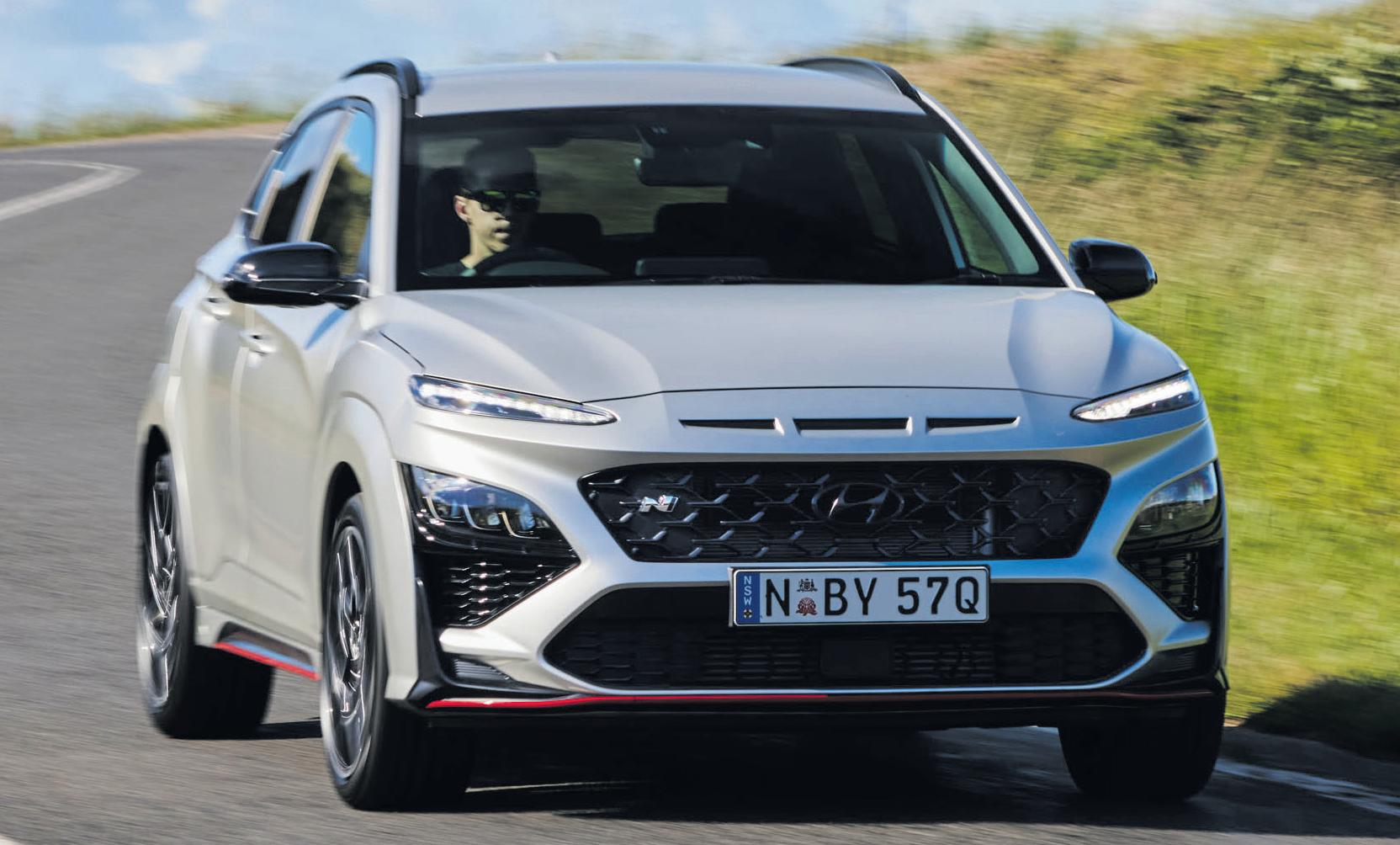
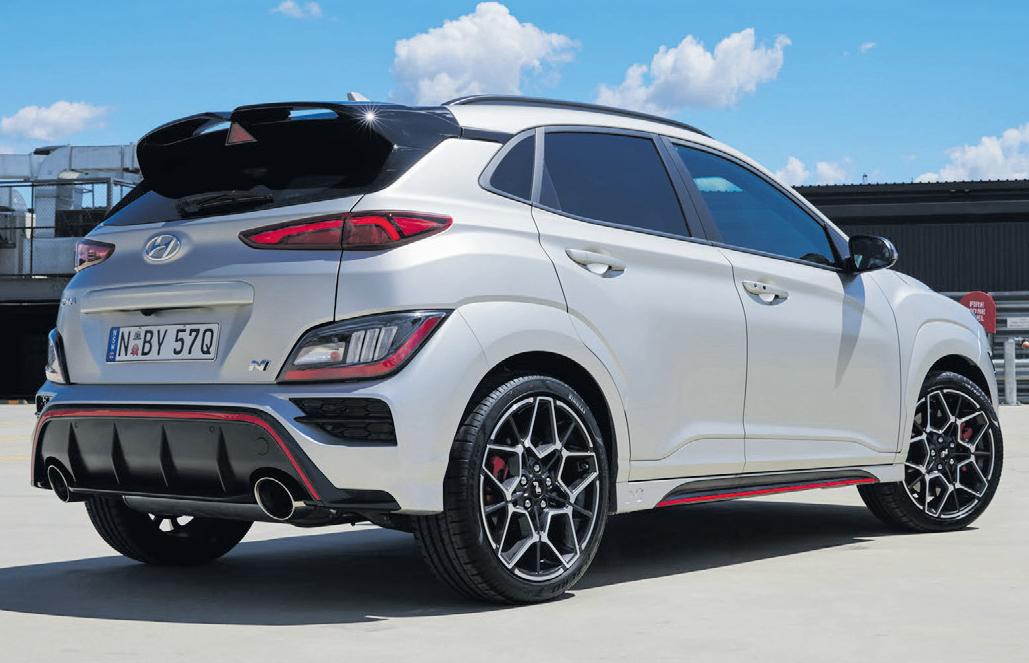
New Ford Mustang coupe and convertible NEW FORD MUSTANG

By EWAN KENNEDY
Ford has announced details of the upcoming new Ford Mustang. Saying that “The seventh generation is the most exhilarating and visceral yet, from its fghter jet-inspired digital cockpit to advanced turbocharged and naturally aspirated engines to its edgier yet still timeless exterior design.” advantage of every pixel,” said Craig Sandvig, Ford Mustang interaction design manager. “We can be creative showing necessary driving information yet also give the driver control to decide how to display everything from selecting colours to classic Mustang gauges to simply creating a ‘calm’ screen where only minimal details are
displayed.”
A race-inspired fat-bottomed steering wheel provides more space when getting seated inside and while performing a heeltoe downshift during spirited driving in manual Mustangs.
The available B&O sound system is optimised for Mustang’s interior, through Apple CarPlay and Android Auto, both of which are fully compatible with Ford’s SYNC 41 system
The low, horizontal brow across the front of Mustang’s aligns with LED headlamps to create an aggressive front end, infuenced by the original 1960s design.
The roofine is optimised for the driver’s entry to and exit from the vehicle without removing their helmet on the track. An extended rear spoiler module has tri-bar lighting and redesigned diffuser for improved aerodynamic balance in the rear.
Ford Mustang convertible has onetouch activation with a single-handle centre latch opens and closes the fully lined and insulated fabric roof.
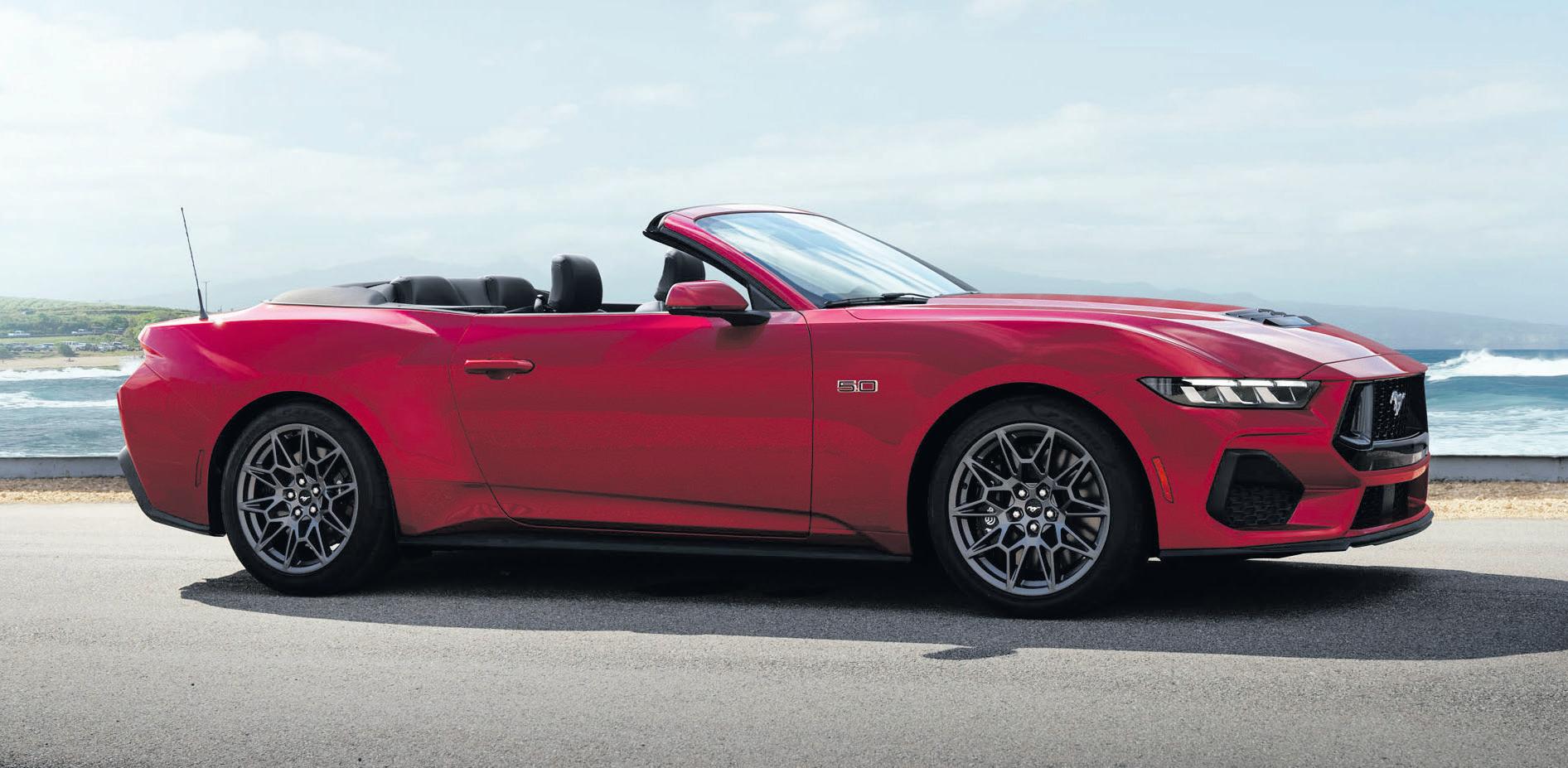
Whether convertible or coupe, V8 or turbopetrol four cylinder, manual or automatic, Mustang has options for multiple prices and performance levels.
Ford Australia will add a special edition nameplate to the Mustang stable, Dark Horse. This is a street and track-capable performance Mustang with striking visual cues a specially modifed 5.0-litre V8. Further specs and information will be released closer to local launch.The seventh-generation Mustang will have a fghter jet-inspired cockpit with two fowing and curved displays that can be customised to show the information the driver wants to see.
“We’re taking
Mustang GT, powered by an advanced, 5.0-litre Coyote V8 engine set to deliver the most naturally aspirated horsepower of any Mustang GT. The 5.0-litre V8 continues to offer a six-speed manual gearbox. A 10-speed automatic transmission is also available, and it almost instantaneously reconfgures its shift patterns to match the selected drive mode.
There’s also an EcoBoost model with an updated, four-cylinder turbocharged 2.3-litre powertrain.
The all-new Mustang will go on sale in Australia in late 2023 and is assembled at Flat Rock Assembly Plant in Flat Rock, Michigan in the United States.
Polestar O2 concept car is set to evolve into the EV specialist’s frst convertible POLESTAR 6 HARD-TOP CONVERTIBLE
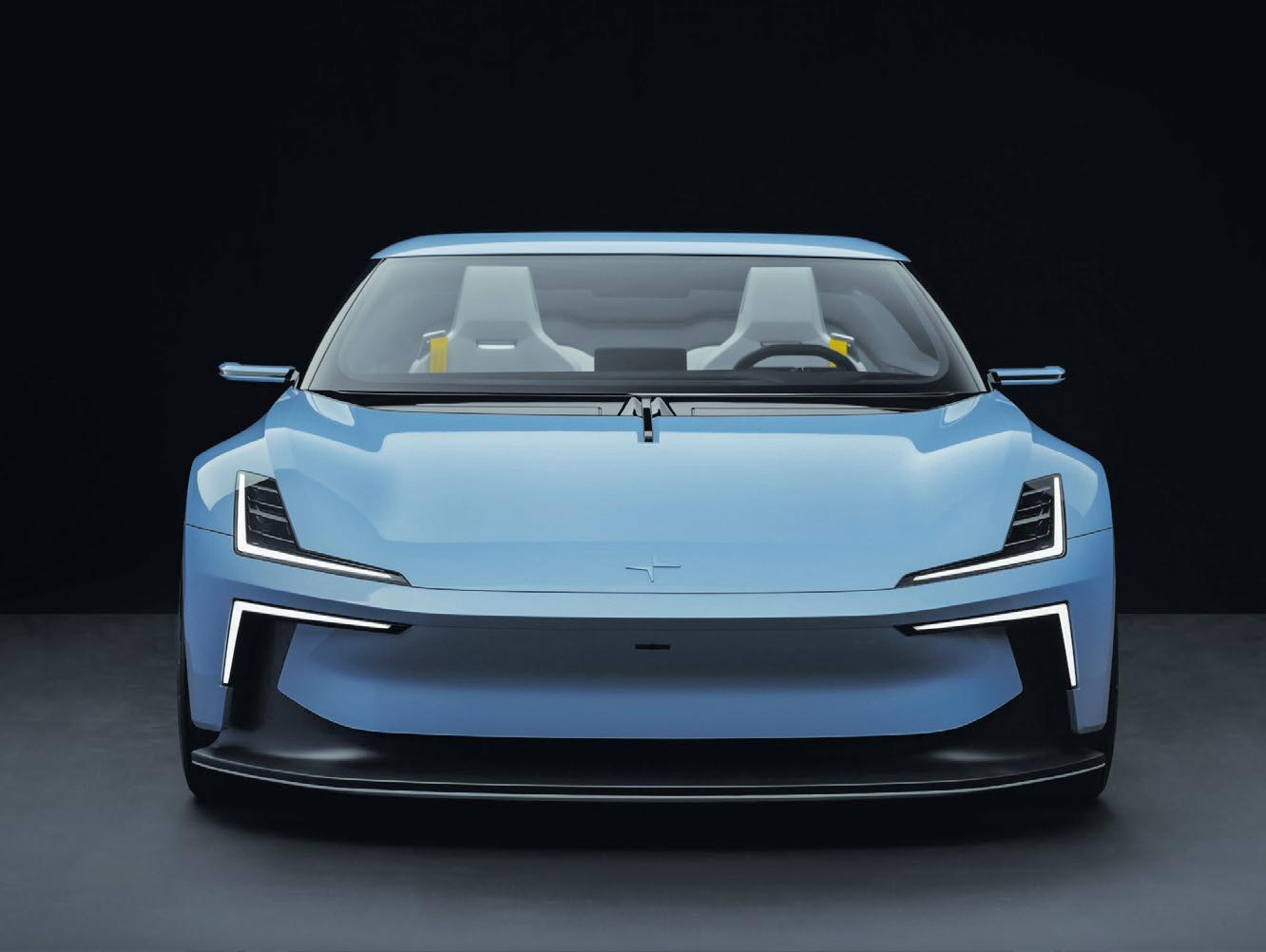
By CHRIS RILEY
Polestar has confrmed it will build an all-electric convertible. Based on the recently revealed O2 concept, it is expected to be launched in 2026 as the Polestar 6. The clearly modern, electric feel.
Polestar’s Head of Design, Maximilian Missoni, describes the car as a meeting point between technology and art, between precision and sculpture, with be painted an exclusive ‘Sky’ blue exterior, light leather interior and unique 21-inch wheels of the original Polestar O2 concept.
“With the overwhelming consumer and press response, we
took the decision to put this stunning roadster into production and I am so excited to make it a reality,” Polestar CEO, Thomas Ingenlath, said, “Polestar 6 is a perfect combination of powerful electric performance and the thrill of fresh air with the top down.”
Further technical details and specifcation confrmations will be released as the production car becomes reality, leading up to the expected launch in 2026.
For more information and to reserve a build slot, you can visit polestar.com/polestar-6.

hard-top convertible will be built on Polestar’s bespoke bonded aluminium platform. Developed in-house, it will feature the highperformance, 800-volt electric architecture already confrmed for Polestar 5. This includes output of up to 650kW and 900Nm from a dual motor powertrain, a targeted 0-100 km/h time of 3.2 seconds and top speed of 250km/h.
The concept features a low and wide body with a compact 2+2 cabin design, minimal overhangs and a long wheelbase, embody classic sports car proportions but with a a determined but not aggressive stance.
A new thermoplastic mono-material features extensively in the interior. Recycled polyester is the sole material used for all the soft components of the interior: foam, adhesive, 3D knit fbres and nonwoven lamination. This simplifes recycling and is a signifcant step towards greater circularity, while also reducing weight and waste.
To celebrate the launch of the convertible, 500 numbered units called the Polestar 6 LA Concept edition, will be offered frst. They will








